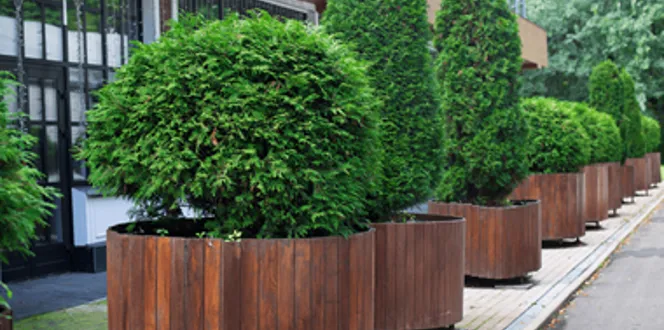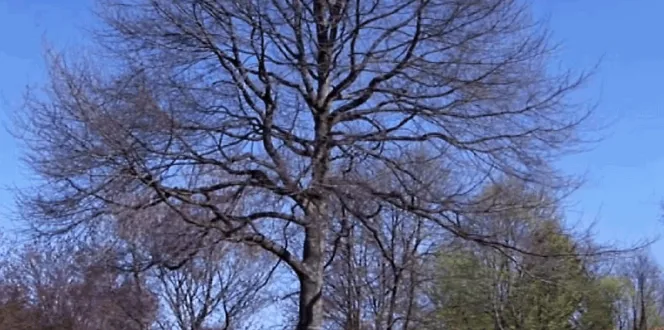There’s nothing better than being able to walk out your back door to your fruit tree and grab a juicy ripe peach or a tart apple and sink your teeth into it.
To have a healthy tree and get good fruit production, planting your trees properly is an essential step. And sometimes you have to move a tree to accommodate changes in your yard or find a better spot for your mini orchard.
You can avoid future problems by following this guide to transplanting fruit trees properly and reaping the rewards of fruit for years to come.
Can You Transplant Fruit Trees? Things to Consider
Transplanting fruit trees takes some good planning.
You can have a successful transplant by factoring in some key areas. Starting things off right is essential to avoid future challenges.
Start by looking at your planting site. Make sure it’s not close to sewer lines, sidewalks or driveways, and powerlines. You want to envision what your tree may look like in 10 years and make sure it won’t interfere with nearby tree branches, that it’s well-drained, and that the site receives 5 to 8 hours of sun. You also want to make sure the soil is rich and fertile; if it’s not, you may want to amend it with compost before planting.
Next, think about timing. While fruit trees can withstand planting throughout the year, the best time of year to transplant fruit trees is in the dormancy state to early spring before their active growth period. Fruit trees should never be transplanted when they have already started developing buds or during the peak growing season.
Then you want to look at the tree you’re moving. The younger the tree, the easier it is to transplant. Trees older than three years require more care during transplant.
When you’re transplanting fruit trees, you want to make a trench on the outside edge of the canopy and dig down 15 to 24 inches to make sure you’re gathering all the major roots. Use a sharp spade to cut any minor roots. Wrap that root ball in damp burlap until you can plant it shortly after. Some additional root prep might be necessary as you dig your tree.
When you’re digging the new hole, remove nearly twice the width of your fruit tree’s current root system, and ensure top of root ball is above planting grade. This way the new roots aren’t cramped. Hold the tree up a bit when filling in your planting hole to allow loose soil to fall under and around the roots and to center the tree and keep it straight. Tamp down the soil to remove air pockets. Another way of removing air pockets is to add water gradually as you backfill the planting hole. This will help the root ball settle properly.
Transplanting Mature Fruit Trees
When it comes to transplanting large fruit trees, you definitely want to wait until the tree is semi-dormant or dormant before moving it for the best chances of success. This means you’ll be moving it after the leaves fall in autumn or before bud break in spring.
Don’t expect a mature tree to grow or fruit in the year after transplanting since it needs at least one year to recover.
The reason larger or more mature trees are harder to move is because a larger portion of roots is lost in the process.
How to Minimize Transplant Shock
Just like when anyone moves from one location to another, there’s a little bit of stress involved.
For fruit trees, when they lose some roots and are moved to a new soil environment, this is stressful and is known as transplant shock.
But if we help them along, we can make our transplanted fruit trees bounce back. Here are some ways you can reduce transplant shock:
- Prepare your soil well by rototilling it so it is loose. Add compost if necessary.
- Make sure your new location has good drainage.
- Have a well-designed irrigation system or good watering plan in place.
- Do not cut more roots off than you need to when transplanting fruit trees.
- Thoroughly water trees after planting. They need 1 inch of water each week. Don’t let the soil dry out.
- Add a 2- to 4-inch deep layer of mulch from the tree’s base to the outermost leaves, be sure to leave a buffer between mulch and trunk base.
Common Mistakes to Avoid When Transplanting Fruit Trees
Can you transplant fruit trees? Absolutely. But proper planning and preparation will ease your tree’s transition.
Avoiding these common mistakes can save you -- and your tree -- from additional stress or headaches.
- Poor planning. Research your fruit tree type and select the right location carefully.
- Wrong season. Remember to transplant fruit trees during the ideal times to avoid excess transplant shock and give your tree the best possible start.
- Ignoring soil health. Making sure your soil is rich in organic matter and fertilizing at least twice a year can help your fruit trees thrive.
- Planting in soil that isn’t well-drained. This is one of the top reasons fruit trees fail. Sandy and loam soils that drain well are best for fruit trees. Clay soil can work as long as water drains off of it within a day or two after rainfall or irrigation. Any soil that stays wet can cause fungal diseases and drown trees.
- Forgetting to mulch. Mulching ensures your soil retains moisture.





